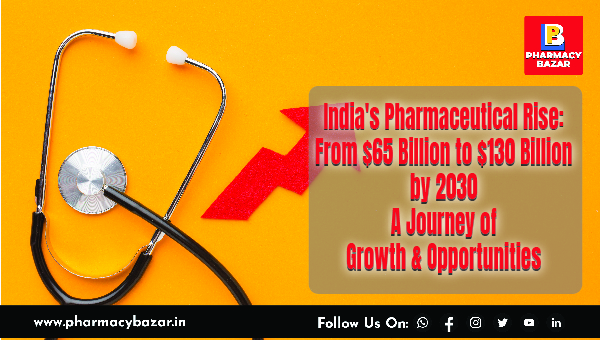India's Pharmaceutical Rise: From $65 Billion to $130 Billion by 2030 - A Journey of Growth and Opportunities
May 28, 2024
The Indian pharmaceutical industry has been experiencing a remarkable growth trajectory over the past few decades. With the liberalization of the market, Indian pharma companies have grown significantly, meeting global standards and becoming well-known names in the international market. Today, Indian pharma companies account for around 35% of the Abbreviated New Drug Application (ANDA) approvals granted by the US Food and Drug Administration (FDA). The industry is poised to reach a staggering $130 billion by 2030, driven by various factors.
Opportunities and Challenges:
The Indian pharmaceutical industry offers a multitude of opportunities for foreign companies to establish their units and market their products in India. The rising demand for quality healthcare in India makes the domestic market quite promising. Additionally, the availability of human resources adept at performing scientific and medicinal research makes India a hub for manufacturing drugs. The cost of production in India is significantly lower compared to the US or European countries, reducing costs by 40 to 50%.
Despite these opportunities, the Indian pharmaceutical industry faces several challenges. The challenges are unique and complex in nature, with up to 30% of medicinal drugs sold in developing countries being fake, which can seriously affect patient health. The government of India, in association with the World Health Organisation (WHO), is taking various measures to prevent this, such as packaging with 2D barcodes and investing more in drug manufacturer inspectors.
Key Players and Government Policies:
The Indian pharmaceutical industry is home to over 3,000 drug companies and 10,500 manufacturing units. About 20% of global exports in generic drugs are met by Indian pharma manufacturers. The industry has also established a strong domestic pharmaceutical segment, with a significant network of manufacturing facilities.
The government has been actively supporting the industry through various policies and initiatives. The Production Linked Incentive (PLI) scheme, for instance, aims to promote domestic manufacturing of critical drugs and has been approved for 136 companies over FY’23-28. The government has also announced the establishment of three bulk drug parks and has allowed 100% foreign direct investments (FDI) for greenfield projects and 74% FDI for brownfield projects.
Future Prospects:
The Indian pharmaceutical industry is expected to continue its growth trajectory, driven by various factors. The market size is expected to reach $65 billion by 2024 and $130 billion by 2030. The industry is poised to play a significant role in the global pharmaceutical market, with India being a major exporter of pharmaceuticals to over 200 countries.
Conclusion:
In conclusion, the Indian pharmaceutical industry is set to reach $130 billion by 2030, driven by various opportunities and government initiatives. The industry faces several challenges, including regulatory compliance, intellectual property rights issues, and counterfeit medicines. However, with the government's support and the industry's resilience, India is poised to become a major player in the global pharmaceutical market.
DISCLAIMER:
This article is the property of Pharmacy Bazar and is protected by copyright laws. The information provided in this article is for educational and informational purposes only and is not intended to be a substitute for professional medical advice, diagnosis, or treatment. Always seek the advice of a qualified healthcare provider with any questions you may have regarding a medical condition. Never disregard professional medical advice or delay in seeking it because of something you have read in this article. The author and publisher of this article do not endorse any specific treatments, procedures, or products mentioned in this article.
Recent Post

Blood Cancer: Early Warning Signs and Diagnosis

Understanding Gallstones: Causes, Symptoms, and Treatment Options

Navigating Diabetes Medications: Benefits and Side Effects

Revolutionizing Cancer Treatment: How Unleashing T Cells' Energy Could Transform Immunotherapy

The Power of Lower Back Stretches: Benefits and Best Yoga Asanas for a Healthy Spine

8 Health Conditions That Could Be Due to Magnesium Deficiency

Unlocking Brain Health: How Lifestyle Choices Impact Cognitive Functions

When Speech Takes a Surprising Turn: Unraveling Foreign Accent Syndrome

The Optimal Time to Take Your Vitamin D Supplement: Insights and Best Practices

Beyond Diabetes: Unveiling the Hidden Health Risks of Insulin Resistance

